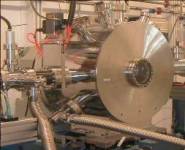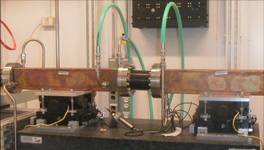
Over the past several years Argonne National Laboratory, a U. S. Department of Energy laboratory managed by UChicago Argonne LLC, has developed and deployed a robust and reliable platform for the control and data acquisition of photon beam applications. The platform consists of a full suite of software development tools and applications, called the Experimental Physics and Industrial Control System (EPICS), which is deployed on a scalable range of target computer systems ranging from high-end RISC workstations running a real-time operating system to a low-end embedded computing platform running Linux. The EPICS environment provides a software infrastructure for use in designing and managing complex, distributed control systems.
At present there are over 250 EPICS control systems deployed in photon beam control applications within the laboratory for controlling among other things white-beam slits, the X-ray monochromator, the USAXS-DEI instrument and mirror control, and the beamlines at the Center for Nanoscale Materials and the Advanced Photon Source.
At the heart of the control system is the EPICS software development and run-time environments. The EPICS development environment is tool based, minimizing the need for custom software development and ensuring uniform operator interfaces. EPICS run-time software can be deployed on a number of operating systems including UNIX, Linux, Solaris, VxWorks, Mac OS, and Windows NT and XP. The resulting application software supports a distributed control environment with an arbitrary number of control systems and operator display stations. The software components are all designed to be event driven, which provides faster response time and more efficient use of system resources.
At the low end of the EPICS target computer systems is the EPICS brick, or EBRICK, implementation that is designed to be a low-cost control solution with soft real-time requirements. The current implementation of the EBRICK is built around the PC/104 Athena single-board computer (SBC) from Diamond Systems. Additional I/O functionality is added onto the SBC in the form of PC/104 I/O cards including Diamond Systems’ Ruby-MM 16-bit DAC module, Onyx-MM digital I/O module, Pearl-MM 16-bit output relay module, and Emerald-MM serial port module. Other hardware components include a smart sensor input, motion controller, I/O breakout boards, a GPIB interface card, and a stepping motor drive. The PC/104 hardware stack is housed in a compact and rugged Pandora enclosure from Diamond Systems, which brings the entire PC and data acquisition signals to the face of the enclosure offering standard connector interfaces. For larger applications a 4U rack-mountable enclosure is also available.
Argonne Laboratory selected the Athena SBC because of the functionality provided by the hardware given the price. Other processors on the market did not provide the additional features such as data acquisition circuitry, on-board video support, and packaging. Also, the lab had prior success with Diamond Systems’ technical support and sales staff. The Diamond Systems’ PC/104 I/O boards were also selected because of functionality, availability, support, and price.

In Sector 32 of the Advanced Photon Source (APS), the ultra-small-angle X-ray scattering (USAXS) facility provides a world-class resource for advanced materials research. Recent projects include characterization of nanoparticle formation in a flame and gradient microstructures in fuel cell layers. The EBRICK system coordinates with a VxWorks system to control the USAXS instrument. In conjunction with a vertically-focusing double mirror system on the beamline controlled by an EBRICK system, delivers a more focused x-ray beam with more x-ray photons to the sample under test. In the same beamline, another EBRICK is deployed to monitor temperatures for the X-ray monochromator crystals.
Also at the APS in Sector 11, a high-resolution x-ray powder diffractometer utilizes an EBRICK system to control an automated sample changer. The industrial robot-based sample exchange automation system is integrated into the powder diffractometer data collection process through the use of a control script run on the EBRICK that coordinates sample mounting, diffractometer control, and data collection. During standard operations, the user loads the samples, interlocks the hutch, and initiates the script; then the robot runs automatically to perform a high throughput operation.
Elsewhere, at the APS in Sector 4, an EBRICK solution is deployed for controlling high-field pulsed magnet instrument and data acquisition electronics. The EBRICK runs an application called SPEC to control and diagnose a capacitor bank that powers the test electronics. The application initiates the test, gathers the data, and then transfers it to another system for storage.
To date there are over 40 EBRICK installations in a wide range of applications controlling motors, XIA Huber photon beam slits, filters, current amplifiers, positioners, mirror systems and nanoprobe beamlines. According to David Kline from the APS Engineering System (AES) Beamline Controls and Data Acquisition (BCDA) group, “The Diamond Systems products and services have enabled our projects to meet their objectives in the time frames required.”
Click here to return to the main article list.